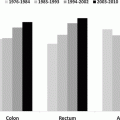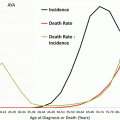Fig. 1.1
Landmark events in the development of AYA oncology in North America. CCG Children’s Cancer Group, NCI National Cancer Institute, PRG Progress Review Group, JAYAO Journal of Adolescent and Young Adult Oncology, IOM Institute of Medicine, NCCN National Comprehensive Cancer Network, Aflac Aflac Foundation, LSYAA LIVESTRONG Young Adult Alliance, CMYACA Critical Mass Young Adult Cancer Alliance

Fig. 1.2
Landmark events in the development of AYA oncology in the United Kingdom. NICE National Institute for Health and Care Excellence, NCRI National Cancer Research Institute

Fig. 1.3
Landmark events in the development of AYA oncology in Australia. PeterMac Peter MacCallum Cancer Centre
In retrospect, the first publication that identified an AYA cancer gap per se appeared in 1996 [11], following which a series of national programs emanated in North America (Fig. 1.1). The Children’s Cancer Group (CCG) created a committee devoted to AYAO research that in 1998 was supported via a Cooperative Group grant from the NCI. In 2000, the first NCI workshop on AYAO was held that stimulated other cooperative groups to include AYAO in their research plans.
Formed in 2005 by a unique partnership between the NCI and the LIVESTRONG Foundation, the Progress Review Group on Adolescent and Young Adult Oncology remains active and in September 2013 hosted a workshop on Next Steps in Adolescent and Young Adult Oncology: An Update on Progress and Recommendations for the Future [12]. Various products of that meeting are under development and being published. The NCI also restructured its cooperative group program with the formation of the National Clinical Trials Network in 2014 [13]. In 2013, COG joined ranks with the NCI adult cooperative group AYA committees to coordinate intergroup efforts to conduct AYAO research, both at the translational and clinical trial levels.
A parallel development in North America was the formation of a Critical Mass Young Adult Cancer Alliance [14], an entity that began life as the LIVESTRONG Young Adult Alliance (LSYAA) under the auspices of the LIVESTRONG Foundation in 2006 [15]. Critical Mass and LSYAA aggregated AYAO-focused nonprofit organizations, medical institutions, patient advocacy groups, government agencies, clinicians, researchers, and dedicated individuals. One of their outcomes was a position statement on the preferred training of health-care professionals for AYAO [16]. That same year, the National Comprehensive Cancer Network issued its supportive care guidelines in AYAO [17], and in 2013 the Institute of Medicine in the USA convened a workshop devoted to this subject [18].
North of the border momentum in AYAO received a major boost in 2008 when funds from the federal government were provided, through the agency of the Canadian Partnership Against Cancer, to establish and operate a national Task Force on Adolescent and Young Adult Cancer. The Task Force has held two international workshops, in 2010 [19] and 2012, that have led to a series of recommendations [20], akin to those of the Progress Review Group, and a Framework for Action [21] to advance the discipline. A parallel activity has resulted in the approval of a 1-year, postgraduate diploma program in AYAO (a designated “Area of Focused Competence”) by the Royal College of Physicians and Surgeons of Canada.
Across “the pond,” there has been a continuing surge of activity (Fig. 1.2) building on the foundation of the Teenage Cancer Trust that has built more than 20 centers for teenagers and young adults, ages 13–24, in the United Kingdom since 1990 and continues to host a biennial international symposium. In 2005 the National Institute for Health and Care Excellence (NICE) in the United Kingdom issued a document entitled “Improving outcomes: Guidance in children and young people with cancer” that recommended, in particular, appropriate referral paths in England [22]. At about the same time, the National Cancer Research Institute formed a Teenage and Young Adult Clinical Studies Group (CSG), and the National Cancer Research Network (NCRN) was established. The NCRN set out to double the accrual to cancer clinical trials within 3 years for patients of all ages, from 3.5 % in 2001. This goal was surpassed easily, with a rate of 14 % achieved, and the United Kingdom was labeled “the cancer clinical trials recruitment capital of the world” [23].
The CSG reported in 2008 that accrual to cancer trials of young adults, ages 20–24 years, had declined and that no AYAs with brain tumors who were older than 16 years had been recruited to available trials [24]. In a report 6 years later [25], the CSG noted that accrual rates 15–19-year-olds had improved considerably. The work of the CSG will be a useful guide for the AYA intergroup of the NCTN.
In continental Europe there was limited activity in AYAO at the national level until 2010. An important boost was the provision of funding for 4 years (2011–2015) from the European Commission to build the European Network for Cancer Research in Children and Adolescents (ENCCA) [26]. This organization spans 11 countries and has 34 partners – health-care institutions, advocacy groups, pharmaceutical companies, regulatory bodies involved in drug development, and the health policy community. Although it will sunset in 2015, ENCCA will continue its work in AYAO as the European Network for Teenagers and Young Adults with Cancer. The success of ENCCA reflects its broad composition of stakeholders, especially the productive interaction between pediatric and medical oncologists, a pattern that has been mirrored in some national projects, as exemplified in Italy where the Associazione Italiana Ematologia Oncologia Pediatrica (AIEOP) that coordinates the care of children with cancer in all 49 children’s hospitals in the country formed a committee on adolescents in 2010. A particular challenge encountered was the considerable variability in the upper age limit for admission to children’s hospitals, some as low as 14 years. The AIEOP committee expanded to form SIAMO (Società Italiana Adolescenti con Malattie Oncoematologiche) that includes oncologists who provide care to adults, among other partners [27].
Stay updated, free articles. Join our Telegram channel

Full access? Get Clinical Tree








